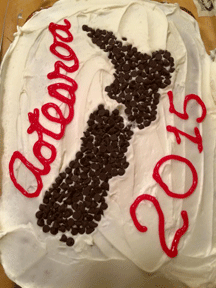The Evergreen State College,
February 12-April 8, 2015
Ko ia kahore nei i rapu, te kitea (“He who does not seek will not find”)
CLASS REPORT: NZ2015.pdf
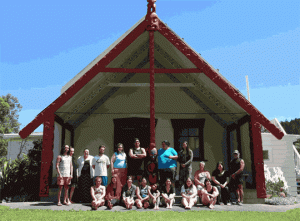
Native Decolonization in the Pacific Rim class at Matatina Marae, Waipoua, Northland, Aotearoa New Zealand
These are photo albums and videos by Dr. Zoltan Grossman, professor of Geography and Native Studies at The Evergreen State College in Olympia, Washington. He co-taught the class Native Decolonization in the Pacific Rim (with Kristina Ackley), comparing Indigenous sovereign nations and treaties in the Pacific Northwest to Maori tino rangatiratanga (sovereignty) and the Treaty of Waitangi in Aotearoa New Zealand. He was in Aotearoa New Zealand from February 12 to April 8, 2015, including a two-week study tour with 15 undergraduate students, visiting the students during their five-week research projects with Indigenous communities and organizations, conducting his own research on Maori opposition to deep-sea oil drilling, and exploring North Island with his wife Debi McNutt. The same study abroad program visited Aotearoa in 2011. Use of photos from these public facebook albums is by permission only; please email grossmaz@evergreen.edu
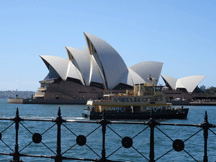 A Day in Sydney, Australia (Feb. 12)
A Day in Sydney, Australia (Feb. 12)
On our way to Auckland NZ, three Evergreen students and I spent a layover day in hot and sunny downtown Sydney. We visited the amazing Sydney Fish Market (largest in the Southern Hemisphere), the extensive Royal Botanical Gardens (including wild cockatoos and ibises), and viewed some Indigenous art (such as in the Art Gallery of New South Wales) before taking the train back to the airport.
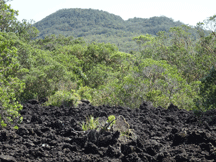 Volcanoes of Auckland: One Tree Hill, Rangitoto Island, & more (Feb. 15)
Volcanoes of Auckland: One Tree Hill, Rangitoto Island, & more (Feb. 15)
As students were coming into New Zealand for our Native Decolonization in the Pacific Rim class, I did some hiking on two iconic volcanic cones that have magnificent views of the isthmus, stretching from the Pacific Ocean to the Tasman Sea.. One Tree Hill is one of the many cones that later served as a Maori pa, or fortified terraced village. It also was where the colonists chopped down a native totara tree in 1852 and planted a pine in its place, which was symbolically felled in a Maori direct action in 1994. Rangitoto Island is a volcano in the Hauraki Gulf that had eruptions only 600 years ago, and an important cultural site co-managed by the Department of Conservation and two hapu (subtribes). The island is covered with lava, almost up to the crater on the summit, and has lava caves to explore.
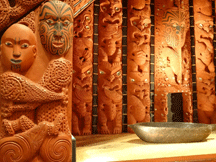 Auckland Museums (Feb. 18)
Auckland Museums (Feb. 18)
Our Native Decolonization in the Pacific Rim class visited the Auckland War Memorial Museum, with its premiere Maori exhibits, and the New Zealand Maritime Museum, with its exhibits on Polynesian voyaging, and the oceangoing waka (canoes) Haunui and Hokule’a.
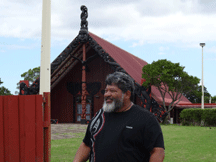 Indigenous Resilience in Auckland (Feb. 20)
Indigenous Resilience in Auckland (Feb. 20)
Our Native Decolonization in the Pacific Rim class visited KFM Radio and Maori Television, community-based poets in the Maori and Pasifika (Pacific Islander) communities of South Auckland, and Orakei Marae, scene of the Bastion Point occupation of the 1970s.
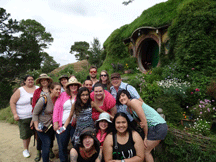 Hobbiton, New Zealand (Feb. 21)
Hobbiton, New Zealand (Feb. 21)
Our Evergreen class took a break from our grueling trip around North Island to tour the movie set of The Hobbit and Lord of the Rings. It was fascinating to see the (empty) Hobbit Holes, how the movie set is kept green, and how some of the trees are artificial. Our students had a fun time, even though Hobbiton wasn’t part of our educational tour (or maybe because it wasn’t).
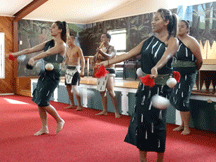 Maori arts and geothermal cooking in Rotorua (Feb. 22)
Maori arts and geothermal cooking in Rotorua (Feb. 22)
Rotorua is New Zealand’s Yellowstone — with geysers, and steam vents and bubbling mud pools all over town. It is also the center of Maori arts and culture, and the tradition of hangi cooking in underground ovens or geothermal steam vents. Our Native Decolonization class stayed at Parua Marae, and visited the Te Puia Maori Arts Centre and Whakarewarewa Thermal Village. We visited with Maori master artists who have been visiting artists at the Evergreen Longhouse: weavers Tina Wirihana, Matekino Lawless, Karl Leonard, and painter June Northcroft Grant, as well as the pounamu (greenstone jade) carver Lewis Gardiner.
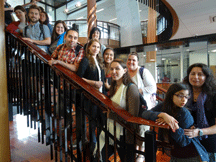 Maori University in Whakatane, Aotearoa NZ (Feb. 24)
Maori University in Whakatane, Aotearoa NZ (Feb. 24)
The Evergreen State College has had a strong relationship with the Maori university Te Whare Wananga o Awanuiarangi, through our Tribal Master of Public Administration program. Prof. Alan Parker has been collaborating with the university (which includes all levels) on a Ph.D. program. This is the first visit of Evergreen undergraduates to Awanuiarangi, through our class Native Decolonization in the Pacific Rim. We have been treated extremely well, with a fantastic meal and light show in a Ngati Awa carved meeting house. We hope to build the relationship into the future. Debi and I returned to Whakatane on March 18 to see our friend Bonnie Savage.
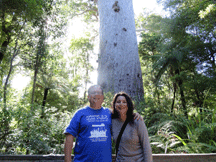 Waipoua Kauri Forest in Northland NZ (Feb. 27)
Waipoua Kauri Forest in Northland NZ (Feb. 27)
Evergreen’s Native Decolonization in the Pacific Rim class stayed three nights at Matatina Marae, on the Kauri Coast north of Auckland. We were hosted by master artists Alex Nathan and Colleen Waata-Urlich, and shown the giant endangered native kauri trees and other plants of the Waipoua Forest. The largest kauri date back 2,000-3,000 years, and so were alive before the arrival of human beings (and other mammals) in New Zealand. Our class also heard about the Te Roroa iwi (tribe) treaty settlement, and how Maori artists are using metals and clay. We swam where the Waipoua River meets the Tasman Sea, witnessed a sunset and the stars of the southern sky.
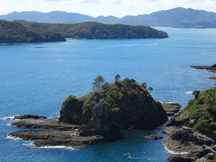 Waitangi and the Bay of Islands, Aotearoa NZ (Mar. 1)
Waitangi and the Bay of Islands, Aotearoa NZ (Mar. 1)
Evergreen’s Native Decolonization in the Pacific Rim class visited the site where the 1840 Treaty of Waitangi was signed between Maori chiefs and the British Crown. From Paihia, we also toured the beautiful Bay of Islands on the historic schooner R. Tucker Thompson, swimming ashore to an island. We finished at the first British colonial outpost of Russell / Kororareka. On March 2 we returned to Auckland and our students dispersed on their weeks-long projects around Aotearoa.
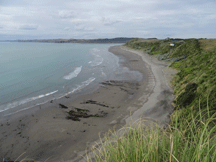 Raglan Beaches & Waitomo Glowworms in Waikato NZ (Mar. 4)
Raglan Beaches & Waitomo Glowworms in Waikato NZ (Mar. 4)
After our students dispersed on their research projects, I began my own project to study opposition by Maori and allies to deep-sea oil drilling off Aotearoa. I went to Raglan, a gorgeous Tasman Sea beach town on the Waikato coast, and scene of a famous 1978 confrontation over tribal land occupied by a golf course (New Zealand’s Oka). I interviewed the daughter of the main Maori protest leader, as well as an ecohostel owner, who are now protecting the seabed against oil and sand extraction. I also drove through the pastoral and hilly Waikato countryside, and visited the Waitomo Glowworm Cave–a longtime dream. Seeing the constellation of bioluminescence in the cave actually moved me to tears — not a common occurrence. Debi and I returned to Raglan on March 16-17.
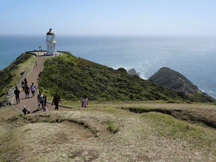 The Brilliant Far North of Aotearoa New Zealand (Mar. 9)
The Brilliant Far North of Aotearoa New Zealand (Mar. 9)
I visited the Northland of Aotearoa New Zealand to hear about the opposition to deep-sea oil drilling–more about that later. But during my visit, I also saw the stunningly beautiful places that the people are defending from oil spills. They include Cape Reinga, the sacred pathway of the dead at the northern tip of the country, Te Rarawa Beach with white silica sand and gentle Pacific waves, 90 Mile Beach with shellfish and crashing Tasman Sea waves, and Ahipara with lava, petrified wood, and sand bluffs. This is a magical landscape wherever you look–no wonder the Maori and their Pakeha
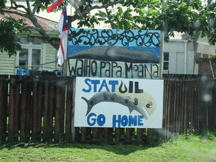 Opposing deep-sea oil drilling in Northland NZ (Mar. 11)
Opposing deep-sea oil drilling in Northland NZ (Mar. 11)
The Norwegian company Statoil is conducting seismic testing for oil off the northern tip of Aotearoa New Zealand. The testing itself may be causing dolphin and whale kills, and any oil spill will be a disaster to the seafood and tourist industry, and Maori culture in the foreshore and seabed. NZ lacks the resources to clean up even a small spill. In Whangarei I attended a rally against the Trans-Pacific Partnership Agreement (TPPA) and spoke with treaty workers, and spoke with Maori and Pakeha defenders of the ocean around Ahipara / Kaitaia and Kerikeri, and visited a Maori TV and radio station that covers the issues.
 Pasifika Festival in Auckland (Mar. 15)
Pasifika Festival in Auckland (Mar. 15)
Auckland is the largest Polynesian city on Earth, and Pasifika is the largest Pacific Islander festival anywhere. It was the most intense and beautiful festival I’ve ever seen. Pasifika consists of 11 villages of different nations–any of the villages could be a festival in its own right. They represent the independent states of Samoa, Fiji, Tonga, Tuvalu, and Kiribati, Aotearoa New Zealand, the NZ possessions of Cook Islands, Tokelau, and Niue, Tahiti in French Polynesia, and the U.S. possession of Hawai’i. Three of our Evergreen students (Hapa, Bronson, and Rachel) were volunteer staff for the festival in Manukau’s Hayman Park. Cyclone Pam’s destruction in Vanuatu and Tuvalu, and its impending impact on Aotearoa today, cast a shadow over the celebration.
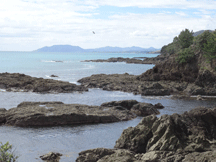 East Cape and Gisborne, Aotearoa NZ (Mar. 21)
East Cape and Gisborne, Aotearoa NZ (Mar. 21)
We visited the most heavily Maori part of North Island, the East Cape, and the city of Gisborne (Tairawhiti) where we had stayed in 2011. The Pacific coast is spectacular in the homeland of the iwi (tribes) Te Whanau a-Apanui and Ngati Porou. They drove out the Brazilian oil company Petrobras from deep-sea oil drilling a few years ago, and local residents are working to stop the Canadian company Tagoil. We visited with three current students in Evergreen’s Native Decolonization in the Pacific Rim program (Erin, Stefanie, and Jesse) who are doing their research in the region, and the amazing artists Tawera and Henare Tahuri.
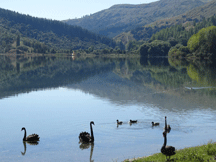 Traveling around North Island NZ (Mar. 26)
Traveling around North Island NZ (Mar. 26)
From Gisborne, we went down the Pacific Coast of North Island to the Hawke’s Bay region, where we explored Napier (rebuilt in art-deco style after a 1931 quake) and then to the Wellington region, where we stayed at a cool farmette in Levin, and in Otaki to attend the Maoriland Film Festival (where three Evergreen students volunteered).
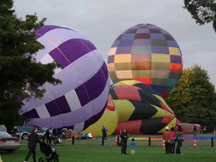 Balloons Over Waikato (Mar. 27)
Balloons Over Waikato (Mar. 27)
The international hot-air balloon festival Balloons Over Waikato is being held in Hamilton, New Zealand. This morning just after dawn, about 15-20 balloons were launched from a park, including a Peg-legged Parrot, Noah’s Ark, and Simba the Lion. We were allowed to walk inside one of the hot-air balloons as it was being inflated, and to be right near the baskets as they slowly and gently rose into the air. I’d never been to a balloon launch, and now I’m hooked.
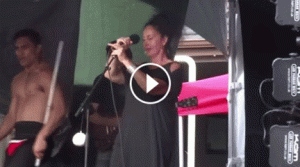 Moana & the Tribe performs “Warrior Woman” in Auckland (Mar. 28)
Moana & the Tribe performs “Warrior Woman” in Auckland (Mar. 28)
We saw the band Moana and the Tribe at the Titirangi Festival of Music in Auckland. I had always wanted to see Moana Maniapoto perform her mix of Maori reggae, soul, and haka, with a political edge. I showed their video “The Whole World’s Watching” to our Evergreen class on Native Decolonization in the Pacific Rim before we traveled to Aotearoa New Zealand. Here, Moana & the Tribe performs “Warrior Woman.” For more see http://www.moananz.com/
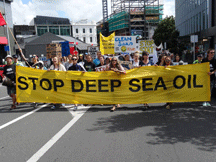 March to Stop Deep-Sea Oil Drilling off NZ (Mar. 29)
March to Stop Deep-Sea Oil Drilling off NZ (Mar. 29)
The March to Stop Deep-Sea Oil Drilling in New Zealand was held to protest an oil industry summit in downtown Auckland, and to show the broad alliance to protect the beaches and marine life of Aotearoa. The march from Victoria Park was opened by the awesome Michael Franti (who I connected to the march organizers with the the help of a facebook friend). The rally drew at least 3,000 people, many with drums, which they beat with gusto in unison as the march arrived at the SkyCity Convention Centre, creating thunderous reverberations within the oil summit. NZ lacks the infrastructure to clean up even a small oil spill, and a large spill would devastate its fishing, tourism, and marine life. Even the seismic testing exploration may be killing whales and dolphins. The issue is a test for NZ sovereignty, and a catalyst to build alliances between Maori and non-Maori communities. Opponents have already blocked the Brazilian company Petrobras, the Texas company Anadarko, and are working to stop the Norwegian company Statoil.
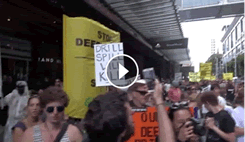 Drumming to Stop Deep-Sea Oil Drilling in NZ (video) (Mar. 29)
Drumming to Stop Deep-Sea Oil Drilling in NZ (video) (Mar. 29)
The March to Stop Deep-Sea Oil Drilling rallied with about 3,000 people and hundreds of drums in downtown Auckland. They protested the Advantage New Zealand Petroleum Summit held at the huge SkyCity Convention Centre,. The buildings provided a perfect echo chamber for the drummers, especially when they beat the drums in perfect unison. The Big Oil reps inside the building must have heard the thunderous reverberations, and shuddered at the prospect of being the next oil company to be kicked out of New Zealand.
 Michael Franti performs at NZ March to Stop Deep-Sea Oil Drilling (video) (Mar. 29)
Michael Franti performs at NZ March to Stop Deep-Sea Oil Drilling (video) (Mar. 29)
Michael Franti performed at the March to Stop Deep-Sea Oil in Aotearoa New Zealand, held to protest an oil industry summit in downtown Auckland. (I connected the march organizers with him, with the help of a facebook friend.) He has been to NZ before, and his song “Bomb the World” was about the 1985 sinking here of the Greenpeace boat Rainbow Warrior. He sang a few songs at the Victoria Park rally, including “Fire,” while waiting for the rally escort. (He commented, “This is the first rally I’ve ever been to where we had to wait for the police….how un-American!”).
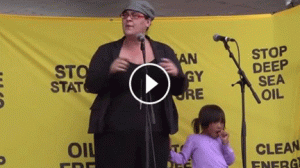 Dayle Takitimu speaks at Anti-Oil Rally in Auckland (video) (Mar. 29)
Dayle Takitimu speaks at Anti-Oil Rally in Auckland (video) (Mar. 29)
Dayle Takitimu of the Te Whanau-a-Apanui iwi (tribe) on the East Cape gave a rousing speech to the March to Stop Deep-Sea Oil Drilling, which drew more than 3,000 people in Auckland. She described how her iwi worked together with Greenpeace to blockade and drive the Brazilian oil company Petrobras out of New Zealand waters. Others have blocked the Texas company Anadarko, and are working to stop the Norwegian company Statoil. The resistance in Aotearoa is an inspiration to those of us in the Pacific Northwest who are fighting to prevent the expansion of the fossil fuel industry in our region.
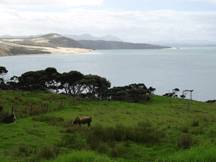 Beautiful Hokianga Harbour in Northland NZ (Apr. 2)
Beautiful Hokianga Harbour in Northland NZ (Apr. 2)
The Hokianga is one of the stunningly beautiful places in Aotearoa New Zealand, and anywhere on Earth for that matter. We stayed in Opononi and visisted Rawene, Kaikohe, and Ngawha. The Hokianga is a center of Maori history and identity, and today strongly opposes oil drilling off the coast. Our visit coincided with the Te Tai Tokerau Kapa Haka Festival at a school down the road, with youth from across the Northland region showing their amazing singing and dancing skills.
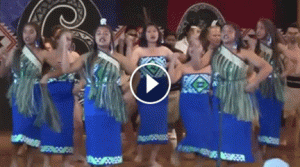 Kapa Haka performance at Northland Maori youth festival (video) (Apr. 1)
Kapa Haka performance at Northland Maori youth festival (video) (Apr. 1)
When we were at Hokianga Harbour in Northland, we were lucky to attend the Te Tai Tokerau Kapa Haka Festival at Opononi Area School. Students from 28 high schools and colleges around the region performed haka and other dances, and waiata (songs) in Te Reo Maori, with gratifying support from the huge crowd. It was a great time, and a fantastic example of cultural and language revitalization among Maori youth. Most Americans have seen only haka dances by men, not by women, and have not seen other beautiful kapa haka songs and dances by both women and men. I posted photos, but only a video can show the raw power of the performances, such as this one by students from Otamatea High School in Maungaturoto.
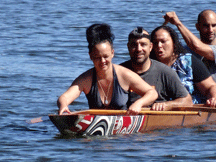 Waka (canoe) carving & launching at Matatina Marae, Waipoua Forest NZ (Apr. 5)
Waka (canoe) carving & launching at Matatina Marae, Waipoua Forest NZ (Apr. 5)
Returned twice to the artists’ marae in Northland to witness the carving of a waka (canoe) from a kauri tree, and its launching in the Waipoua River. We were hosted by the Nathan family at Matatina Marae. It was the first time in many decades that a waka was made in Te Roroa iwi (tribe) territory, and the first time that carver Will Ngakuru and painter Andrea Eve Hopkins had worked on a waka of that size. They, other artists, and videographer Daniel Nathan, were joined by Evergreen student Hayden Zabel on the first weekend of March. On the first weekend of April, Debi and I visited to witness the launching of the waka, named Te Hiringa (Revitalization), and to see the local youth paddle it for the first time. Matatina Marae is hosting a series of wananga (tribally based teaching gatherings) called Te Rau Titapu, to engage Waipoua community members in building connections with the land and each other.
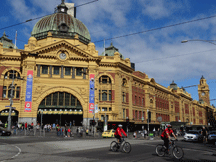 A Day in Melbourne, Australia (Apr. 8)
A Day in Melbourne, Australia (Apr. 8)
We have spent 43 hours in Wednesday, April 8. We flew west from New Zealand to Melbourne, Australia, then across the Pacific to LA, Seattle, and home on the same day we left! We spent four hours in downtown Melbourne, which combines historic buildings straight from old postcards with interesting and colorful postmodern architecture. We explored Parisian shopping arcades and narrow alleyways with sidewalk cafes, and visited the Koorie Heritage Trust, an Indigenous gallery, museum, and social center. It was a great end to the two-month journey. Now it’s time to experience reverse culture shock in the U.S., see family, friends, and Sammy, and get back to teaching the class that brought me on this adventure.
Dr. Zoltán Grossman
Member of the Faculty in Geography /
Native American & World Indigenous Peoples Studies,
The Evergreen State College
TESC Lab 1, 2700 Evergreen Parkway NW
Olympia, WA 98505 USA
E-mail: grossmaz@evergreen.edu
Website: https://sites.evergreen.edu/zoltan/
